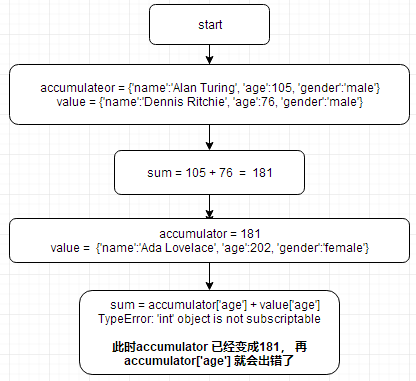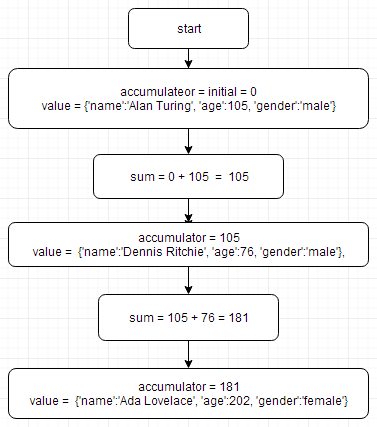1、python2 中,reduce函数是内置函数
2、python3 中,函数被移到了functools模块中
3、官方文档:
reduce(...)
reduce(function, sequence[, initial]) -> value
Apply a function of two arguments cumulatively to the items of a sequence,
from left to right, so as to reduce the sequence to a single value.
For example, reduce(lambda x, y: x+y, [1, 2, 3, 4, 5]) calculates
((((1+2)+3)+4)+5). If initial is present, it is placed before the items
of the sequence in the calculation, and serves as a default when the
sequence is empty.
从左到右对一个序列的项累计地应用有两个参数的函数,以此合并序列到一个单一值。
例如,reduce(lambda x, y: x+y, [1, 2, 3, 4, 5]) 计算的就是((((1+2)+3)+4)+5)。
如果提供了 initial 参数,计算时它将被放在序列的所有项前面,如果序列是空的,它也就是计算的默认结果值了
4、解释:
reduce有三个参数:
- function:有两个参数的额函数, 必需参数
- sequence: 元组、列表等可迭代对象, 必需参数
- inital: 初始值, 可选参数
5、reduce的工作过程是:
在迭代sequence(tuple ,list ,dictionary, string等可迭代物)的过程中,
- 首先把 前两个元素传给 函数参数,函数加工后,
- 然后把得到的结果和第三个元素作为两个参数传给函数参数,
- 函数加工后得到的结果又和第四个元素作为两个参数传给函数参数,依次类推
如果传入了 initial 值, 那么首先传的就不是 sequence 的第一个和第二个元素,而是 initial值和 第一个元素。
经过这样的累计计算之后合并序列到一个单一返回值
7、初阶1
from functools import reduce
def add(x,y):
return x+y
reduce(add,[1,2,3,4])其实就相当于 1 + 2 + 3 + 4 = 10, 如果把加号改成乘号, 就成了阶乘了
当然 仅仅是求和的话还有更简单的方法,
sum([1,2,3,4])108、初阶2
把一个整数列表拼成整数:
from functools import reduce
reduce(lambda x, y: x * 10 + y, [1 , 2, 3, 4, 5])123459、进阶1
from functools import reduce
scientists =({'name':'Alan Turing', 'age':105, 'gender':'male'},
{'name':'Dennis Ritchie', 'age':76, 'gender':'male'},
{'name':'Ada Lovelace', 'age':202, 'gender':'female'},
{'name':'Frances E. Allen', 'age':84, 'gender':'female'})
def reducer(accumulator , value):
sum = accumulator['age'] + value['age']
return sum
total_age = reduce(reducer, scientists)
print(total_age) 'int' object is not subscriptable
错误分析:
第一轮循环时:accumulator = {'name':'Alan Turing', 'age':105}
value = {'name':'Dennis Ritchie', 'age':76}
第二轮循环时:accumulator = sum = 105 + 76 = 181
value = {'name':'John von Neumann', 'age':114}
所以报错,如下图:
修改:
from functools import reduce
scientists =({'name':'Alan Turing', 'age':105, 'gender':'male'},
{'name':'Dennis Ritchie', 'age':76, 'gender':'male'},
{'name':'Ada Lovelace', 'age':202, 'gender':'female'},
{'name':'Frances E. Allen', 'age':84, 'gender':'female'})
def reducer(accumulator , value):
sum = accumulator + value['age']
return sum
total_age = reduce(reducer, scientists, 0)
print(total_age)结果:
467分析:
reduce 有三个参数, 第三个参数是初始值的意思,是可有可无的参数。
修改之后就不出错了,流程如下:
这个仍然也可以用 sum 来更简单的完成
sum([x['age'] for x in scientists ])10、进阶2
from functools import reduce
scientists =({'name':'Alan Turing', 'age':105, 'gender':'male'},
{'name':'Dennis Ritchie', 'age':76, 'gender':'male'},
{'name':'Ada Lovelace', 'age':202, 'gender':'female'},
{'name':'Frances E. Allen', 'age':84, 'gender':'female'})
def group_by_gender(accumulator , value):
accumulator[value['gender']].append(value['name'])
return accumulator
grouped = reduce(group_by_gender, scientists, {'male':[], 'female':[]})
print(grouped){'male': ['Alan Turing', 'Dennis Ritchie'], 'female': ['Ada Lovelace', 'Frances E. Allen']}参考:
https://www.cnblogs.com/lonkiss/p/understanding-python-reduce-function.html

